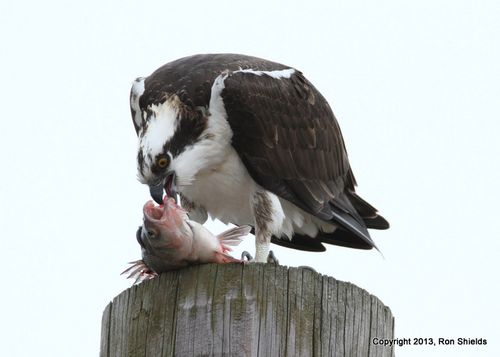
Ron Shields of Kearny photographed this Osprey eating a fish dinner on March 17 of this year.
Jim Wright, who keeps this blog for the Meadowlands Commission, also writes a twice-monthy column for the South Bergenite. Here's his latest, on Ospreys.
For bird-lovers, there are four guaranteed signs of spring in the Meadowlands: killdeer, tree swallows, great egrets and ospreys.
The killdeer arrived near DeKorte Park in Lyndhurst in mid-February. The tree swallows followed suit two weeks later. On Saturday, March 16, came the first great egret.
Then, last week, came perhaps the best news of all. Photographer Ron Shields e-mailed me to say that he had seen his first osprey of the year – eating a fish on top of a pole on Disposal Road, not far from DeKorte Park.
Ron’s comment: “I believe that's a white perch on the menu.” [See the accompanying photo].
As far as we know, this particular osprey did not stick around. But several sure did last spring, including a pair that successfully nested on a nesting platform on Berry’s Creek along Valley Brook Avenue. It was the first time in several decades that ospreys had successfully nested in Lyndhurst.
The story continues below.
Slowly but surely, ospreys are repopulating the Meadowlands. The first successful nest — and still active as of last summer — was near the PSE&G plant in Jersey City in 2006. Then came a nest in Kearny, by the swing bridge across the Hackensack River at Laurel Hill. Three years ago, ospreys started nesting successfully again in Carlstadt.
Last summer came the Lyndhurst nest, plus a second nest at the swing bridge. Yet another new nest, on the lift bridge to the north of Laurel Hill, failed — but first year nests are often called “starter nests” for a reason. The young couple frequently returns the following spring and is successful.
Ospreys have been returning to the Meadowlands for two reasons.
The first reason applies to all ospreys in the United States, as well as bald eagles and peregrines falcons east of the Mississippi River. The widespread misuse of the pesticide DDT a half-century ago weakened the shells of the raptors eggs to the point where they would break when the parents incubated them. Once the pesticide was banned, all three species have slowly made a comeback.
The reason that ospreys have been returning to the Meadowlands District in particular is because these raptors eat almost nothing but fish and because the water quality of the Hackensack River has been improving for more than three decades — to the point where there are lots of free meals for the ospreys.
A decade ago, you were a fortunate person indeed if you saw an osprey hover over the water, then hit the water talons first and come up with a live fish at DeKorte Park or anywhere along the Hackensack River. It was an extraordinary sight back then, but this summer it will once again be commonplace here as the ospreys of the Meadowlands raise their newest offspring.
I can’t wait.
